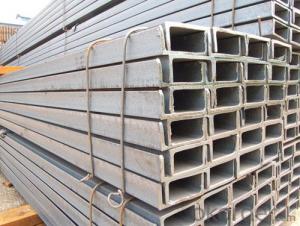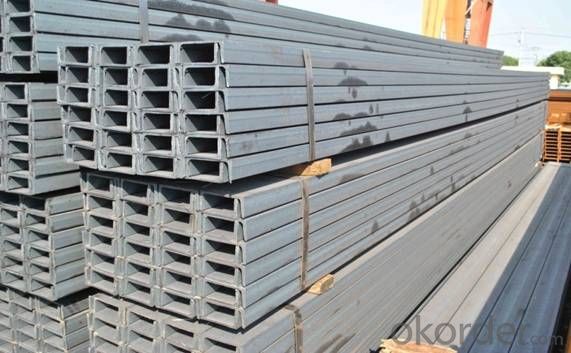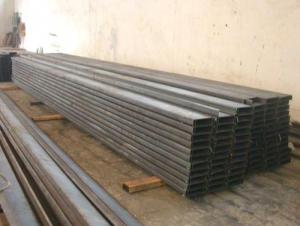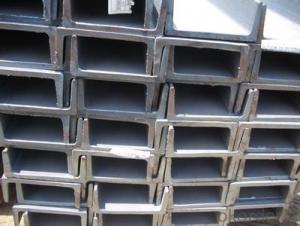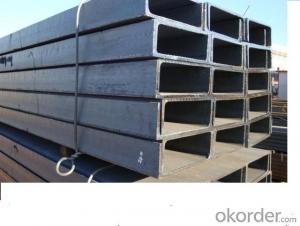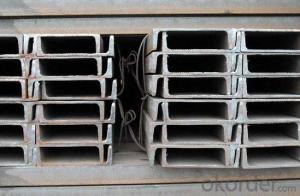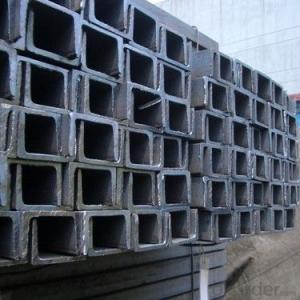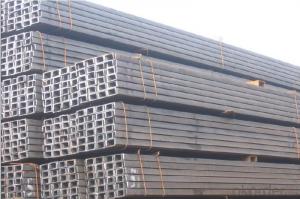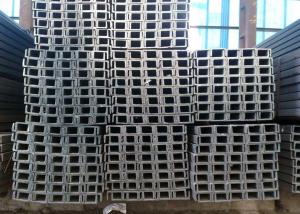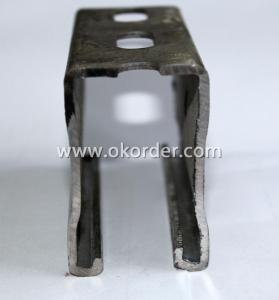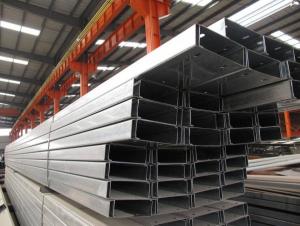GB Standard Steel Channel 100mm with High Quality
- Loading Port:
- China Main Port
- Payment Terms:
- TT or LC
- Min Order Qty:
- 25 m.t
- Supply Capability:
- 10000 m.t/month
OKorder Service Pledge
OKorder Financial Service
You Might Also Like
Product Description:
Specifications of GB Standard Steel Channel 100mm with High Quality:
1. We are definitely specializing in manufacturing and supplying channel steel.
| Standard: | GB/T 6723-86 |
| Sizes: | 50mm to 300mm |
| Sales Volume/Year: | 10000MT |
| Destination Area: | Middle East, Africa, Southeast Asia |
2.Size, Length and Mass of GB Standard Steel Channel 100mm with High Quality.
| Size(mm) | Length(m) | Mass(Kg/m) |
100*50*4 mm | 6m, 12m | 5.778 kg/m |
| 100*50*5 mm | 6m, 12m | 7.065 kg/m |
| 100*50*6 mm | 6m, 12m | 8.337 kg/m |
Package & Delivery of GB Standard Steel Channel 100mm with High Quality:
The steel u channel will be packed in bundle with steel wire at each end of every bundle and color marking in order to help the customer to recognize his goods more easily at sight.
And steel u channel could be loaded into 20ft or 40ft container, or by bulk cargo. If the weight of each bundle reaches less than 3.5 mt, the loading by break bulk cargo should be choosed. When the weight of each bundle reaches less than 3mt, the loading by container should be choosed.
As for the transportaion from mill to loading port, the truck will be usually used. And the maximum quantity for each truck is 40mt.
All in all, we could do in accordance with customer's request.
FAQ:
Q1: How soon can we receive the product after purchasement?
A1: Within three days of placing an order, we will begin production. The specific shipping date is dependent upon international and government factors, but is typically one month.
Q2: How do you guarantee the quality of our products?
A2: We have established an advanced quality management system which conducts strict quality tests at every step, from raw materials to the final product. At the same time, we provide extensive follow-up service assurances as required.
Q3: The prices are invoicing on theoritical weight or on actual weight?
A3: We can do it in both manners, according to the customers' request.
Images of GB Standard Steel Channel 100mm with High Quality:
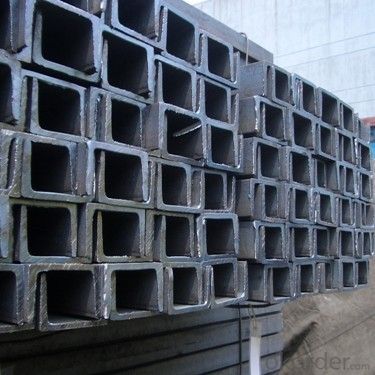
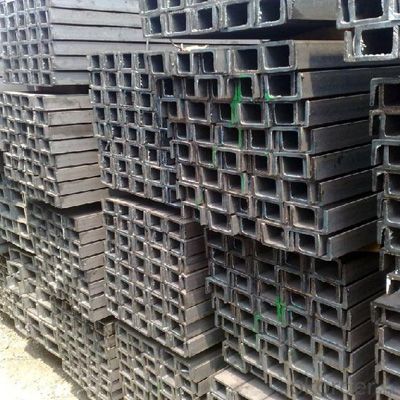
If you would like to get our price, please inform us the standard/material, size and quantity. Thank you very much.
- Q: How do steel channels contribute to the stability of crane runways?
- Steel channels contribute to the stability of crane runways in several ways. Firstly, they provide a strong and rigid support structure for the crane to operate on. The channels are typically made from high-quality steel, which is known for its durability and load-bearing capacity. This ensures that the crane runway can withstand the heavy weight and dynamic loads imposed by the crane during its operation. Moreover, steel channels are designed to distribute the load evenly across the supporting beams or columns. This helps to prevent concentrated stress points and ensures that the load is spread out over a larger area, reducing the risk of structural failure or collapse. By distributing the load effectively, steel channels help to maintain the stability of the crane runway, even when subjected to heavy loads or sudden movements. Another important role of steel channels in crane runways is their ability to resist lateral forces. When a crane moves along the runway, there may be lateral forces generated due to wind, uneven loading, or sudden changes in direction. Steel channels provide a robust framework that can effectively resist these lateral forces, preventing any excessive deflection or sway in the runway structure. This is crucial for maintaining the stability and safety of the crane during its operation. Furthermore, steel channels can be easily fabricated and installed, allowing for efficient construction of crane runways. They can be customized to meet the specific requirements of the crane and the site, ensuring a precise fit and optimal performance. The versatility of steel channels also allows for various configurations and layouts, enabling the design of crane runways that can accommodate different crane sizes and load capacities. In summary, steel channels play a vital role in ensuring the stability of crane runways. Their strength, load-bearing capacity, and ability to distribute loads evenly contribute to the overall structural integrity of the runway. Additionally, their resistance to lateral forces and ease of installation make them an ideal choice for constructing reliable and safe crane runways.
- Q: Is channel steel cold rolled or hot rolled?
- Channel steel is divided into ordinary channel steel and light channel steel. Standard Specification for hot-rolled plain channel steel is 5-40#. Specifications for hot rolled flexible channel steel supplied by supply and demand agreement are 6.5-30#. Channel steel is mainly used for building structures, vehicle manufacturing, other industrial structures and fixed plates, cabinets, etc., and channel steel is often used in conjunction with i-beam.
- Q: How do steel channels contribute to the overall energy efficiency of a building?
- Steel channels can contribute to the overall energy efficiency of a building in several ways. Firstly, they offer structural support, allowing for the construction of taller and larger buildings with less material, reducing overall energy consumption during the construction phase. Additionally, steel channels are often used for insulation purposes, acting as thermal barriers to minimize heat transfer and improve the building's insulation efficiency. Furthermore, steel channels can be designed to accommodate wiring and plumbing systems, optimizing space utilization and reducing energy losses associated with long wire or pipe runs. Overall, steel channels play a crucial role in enhancing the energy efficiency of a building by providing strength, insulation, and efficient utility distribution.
- Q: What are the advantages of channel steel?
- Channel steel is divided into ordinary channel steel and light channel steel. Standard Specification for hot-rolled plain channel steel is 5-40#. Specifications for hot rolled flexible channel steel supplied by supply and demand agreement are 6.5-30#. Channel steel is mainly used in building structures, vehicle manufacturing and other industrial structures, and channel steel is often used in conjunction with i-beam.
- Q: Can steel channels be used for signage installations?
- Signage installations can indeed utilize steel channels. These channels offer a strong and enduring framework that supports and mounts signage. They are widely employed in outdoor signage installations, including billboards, roadside signs, and large-scale displays. Due to their exceptional structural integrity, steel channels can withstand diverse weather conditions, guaranteeing the stability and long life of the signage. Moreover, steel channels can be tailored and crafted to meet the precise requirements of the signage, enabling accurate installation and alignment. All in all, steel channels are a dependable and resilient option for signage installations.
- Q: What are the different surface finish options for steel channels?
- There are several surface finish options available for steel channels, each offering its own unique properties and visual appeal. Some of the common surface finishes for steel channels include: 1. Hot-dip galvanized: This finish involves immersing the steel channel in a molten zinc bath, creating a protective coating that prevents corrosion. It provides excellent durability and a matte gray appearance. 2. Powder coating: Powder coating is a popular option for steel channels as it offers a wide range of colors and textures. The process involves applying a dry powder to the surface of the channel and then baking it to create a smooth and durable finish. 3. Painted: Painting steel channels allows for customization in terms of color and finish. The channels are typically primed before applying the desired paint, which can be either solvent-based or water-based. This finish provides good protection against rust and adds an aesthetic appeal. 4. Stainless steel: Steel channels can also be left with a natural stainless steel finish, which offers excellent corrosion resistance and a sleek, modern look. This finish is commonly used in applications where hygiene and cleanliness are crucial, such as in the food and beverage industry. 5. Anodized: Anodizing is a surface treatment that is commonly used for aluminum, but can also be applied to steel channels. It involves creating a layer of oxide on the surface of the channel, which enhances corrosion resistance and provides a decorative finish. Anodized steel channels are available in a variety of colors. 6. Electropolishing: This finish involves immersing the steel channel in an electrolyte bath and passing an electric current through it. The process removes a thin layer of metal, resulting in a smooth and shiny surface. Electropolishing improves corrosion resistance and is often used in applications where cleanliness and aesthetics are important, such as in the pharmaceutical and medical industries. Overall, the choice of surface finish for steel channels depends on the specific application requirements, desired aesthetics, and the level of corrosion resistance needed. It is important to consider factors such as durability, maintenance, and cost when selecting the appropriate surface finish for steel channels.
- Q: Are steel channels suitable for the oil and gas industry?
- Steel channels are well-suited for the oil and gas industry, as they possess exceptional strength, durability, and resistance to corrosion. In this industry, steel is widely utilized due to these attributes. Specifically, steel channels are commonly employed for structural support and framing in various oil and gas facilities, including pipelines, refineries, and offshore platforms. The utilization of steel channels ensures a remarkable load-bearing capacity, enabling them to withstand the demanding conditions typically encountered in the oil and gas industry. These conditions involve extreme temperatures, high pressures, and exposure to corrosive substances. Moreover, steel channels are easily fabricated and installed, making them a cost-effective option for a wide range of applications. Furthermore, steel channels can be tailored to meet specific requirements, such as varying sizes, lengths, and thicknesses. This adaptability ensures their compatibility with the unique demands of different oil and gas projects. Additionally, steel channels can be galvanized or coated with protective coatings to enhance their resistance to corrosion. This further extends their lifespan and minimizes the need for maintenance. In conclusion, steel channels possess numerous advantages that render them well-suited for the oil and gas industry. These advantages encompass their strength, durability, resistance to corrosion, ease of fabrication and installation, and customization options. Consequently, the utilization of steel channels contributes to the reliable and efficient operation of oil and gas facilities, making them the preferred choice in this industry.
- Q: What are the different types of steel channel connections for roof trusses?
- There are several types of steel channel connections commonly used for roof trusses, including bolted connections, welded connections, and riveted connections. Each type offers different benefits and considerations in terms of strength, cost, ease of installation, and maintenance. The choice of connection type depends on factors such as the load requirements, design preferences, and available resources.
- Q: How are steel channels connected to other structural elements?
- Steel channels are typically connected to other structural elements through various methods such as welding, bolting, or using mechanical connectors. Welding is a common method used to connect steel channels to other structural elements. This involves melting the base metal of the channel and the adjacent structure, fusing them together to create a strong and permanent connection. Welding provides excellent strength and rigidity, making it suitable for heavy-duty applications. Bolting is another commonly used method to connect steel channels. It involves drilling holes through the flanges of the channel and the adjacent structure, and then inserting bolts through these holes to secure the connection. Bolting provides a flexible and reversible connection, allowing for easy disassembly or modification if needed. Mechanical connectors, such as beam clamps or channel connectors, can also be used to connect steel channels to other structural elements. These connectors often have a design that allows them to be easily attached to the channel and then secured to the adjacent structure using bolts or other fasteners. Mechanical connectors provide a convenient and efficient way to connect steel channels without the need for welding or complex fabrication. The method of connection used depends on various factors such as the structural design, load requirements, accessibility, and project specifications. Engineers and designers carefully consider these factors to determine the most suitable method of connecting steel channels to other structural elements, ensuring a secure and durable connection that meets the project's requirements.
- Q: Installation of floor type distribution box, foundation channel production and installation, the quota should choose which two?
- Floor type distribution box installation cannot apply the distribution cabinet installation, and should set floor type of distribution box installation quota; installation set foundation channel steel foundation channel steel installation item.The foundation channel steel production: the foundation channel steel is not installed item containing material, quantity of steel plate, galvanized flat steel, round steel is installed base grounding of the auxiliary channel and. To calculate the foundation channel steel production, making composite iron production, the quantity of round bar, angle steel, flat steel can be unified to channel.
Send your message to us
GB Standard Steel Channel 100mm with High Quality
- Loading Port:
- China Main Port
- Payment Terms:
- TT or LC
- Min Order Qty:
- 25 m.t
- Supply Capability:
- 10000 m.t/month
OKorder Service Pledge
OKorder Financial Service
Similar products
Hot products
Hot Searches
Related keywords
